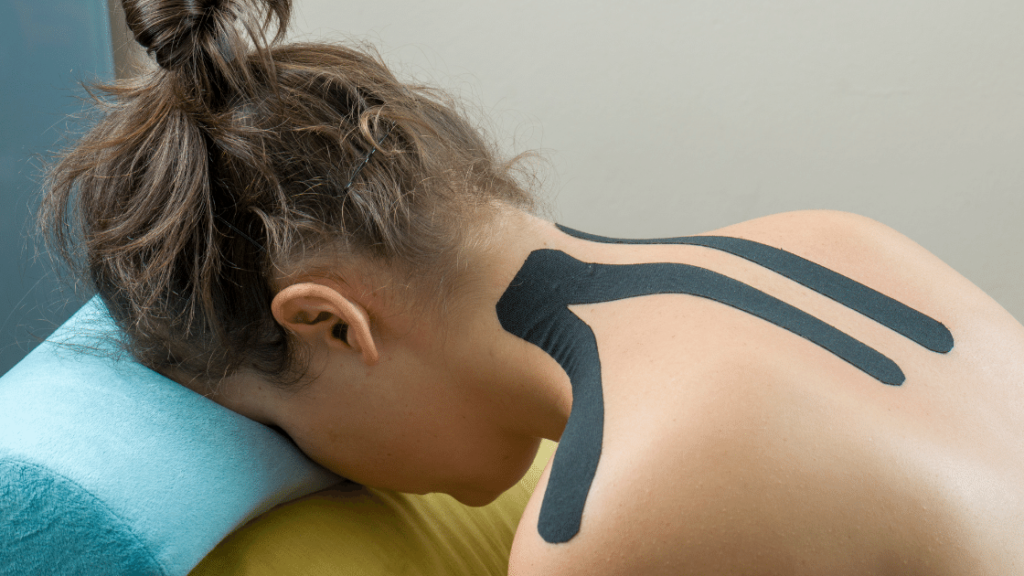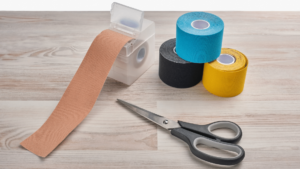Kinesio Taping

“Why do all these Denver Broncos have giant band-aids on their arms and legs?” I’m asked this question almost every time I watch football with people who don’t massage athletes for a living. “Those aren’t giant band-aids, silly! They’re–” and that’s when the very person who asked the question becomes disinterested and starts yelling at the refs.
Since you’re here, why don’t I tell you the answer to that question instead? What is that giant band-aid thing and why is it there?
It’s Kinesio tape, and it’s there for muscular healing! But how does it do that? Let’s talk about it!
How Does Kinesio Tape Work?
What exactly is that adhesive doing?
When Kinesio tape is applied to the skin, its elasticity will gently lift the skin away from the tissue below. This will provide space between the skin and muscles, allowing blood and lymph to properly flow through the area.
Do you know what happens when your blood and lymph get congested? Fascia — a thin layer of connective tissue that encases every muscle, nerve, nerve, blood vessel, and organ in the body — becomes sticky. The stickiness causes the nerves, which the fascia is supposed to protect, to press down into the muscle below. This leads to sensitive spots in the body called trigger points, which can be painful to the touch and restrict tissue movement. So when Kinesio tape is creating space for healthy circulation, the nerves are decompressed. From there, pain receptors will send a message to the brain to reduce the discomfort.
What are the Benefits of Kinesio Tape?
We addressed the healthy circulation benefit, yes. And we also explained how healthy circulation contributes to pain relief. But what else can that improved circulation and reduced pain do for the body?
- Speed up recovery – Get that lymph flowing to where it needs to flow! Let the lymph push the toxins toward the lymph node! Neutralize that sickness-causing junk!
- Reduce swelling and inflammation – Again, sic the lymph on those edema-causing wastes!
- Improve joint and muscular function – Don’t let trigger points impede your range of motion! Let the blood feed sweet oxygen to your tired muscles and bones.
- Prevent muscular pain and stiffness – The tape doesn’t just quell the pain, it prevents it too. If you take care of that space between your skin and your muscles, you’re less likely to encounter trigger points.
Contraindications
While Kinesio tape is considered safe for most, it does come with contraindications. Avoid Kinesio tape if you have any of the following:
- Cancer
- Diabetes
- Allergy to adhesives
- Sensitive skin
- Deep vein thrombosis
- Removed lymph nodes
- Open wounds
Now you know!
If you want to try out some kinesiology tape, bring it up at your next visit! See for yourself how some RockTape treats your body!

Katrina Jenkins
Author, Licensed Massage Therapist
Katrina Jenkins graduated from Towson University in 2013 with a Bachelor’s Degree in Health Science and worked as a nurse’s aide briefly before pursuing her true passion. She graduated from the Massage Therapy Institute of Colorado in April 2016 with honors and completed the Touch of Healers Scholarship Program the following summer. She has been a part of the Moyer Total Wellness Team since the summer of 2017.
Resources
Joy, Rebecca. “What Is Kinesiology Tape?” Healthline, Healthline Media, 20 Mar. 2019, www.healthline.com/health/kinesiology-tape#contraindications.
“Muscle Pain: It May Actually Be Your Fascia.” Www.Hopkinsmedicine.org, www.hopkinsmedicine.org/health/wellness-and-prevention/muscle-pain-it-may-actually-be-your-fascia#:~:text=What%20is%20fascia%3F. Accessed 3 Dec. 2020.
Wu, Wei-Ting, et al. “The Kinesio Taping Method for Myofascial Pain Control.” Evidence-Based Complementary and Alternative Medicine, 21 June 2015, www.hindawi.com/journals/ecam/2015/950519/.
—. “The Kinesio Taping Method for Myofascial Pain Control.” Evidence-Based Complementary and Alternative Medicine, vol. 2015, no. PMID: 26185522, 2015, pp. 1–9, www.ncbi.nlm.nih.gov/pmc/articles/PMC4491400/, 10.1155/2015/950519.
Photo Credit
Canva by Sunlight 19 from Getty Images
Canva by suravikin from Getty Images

